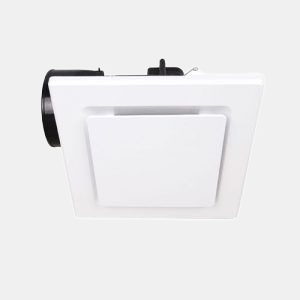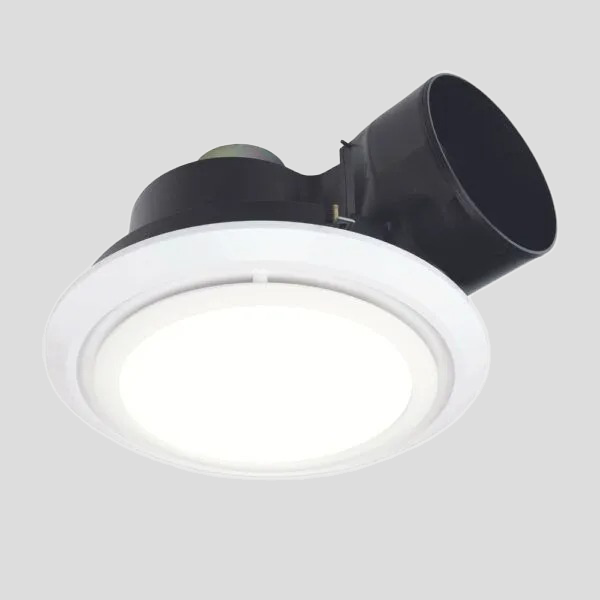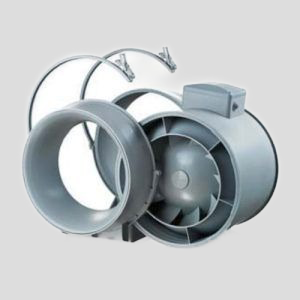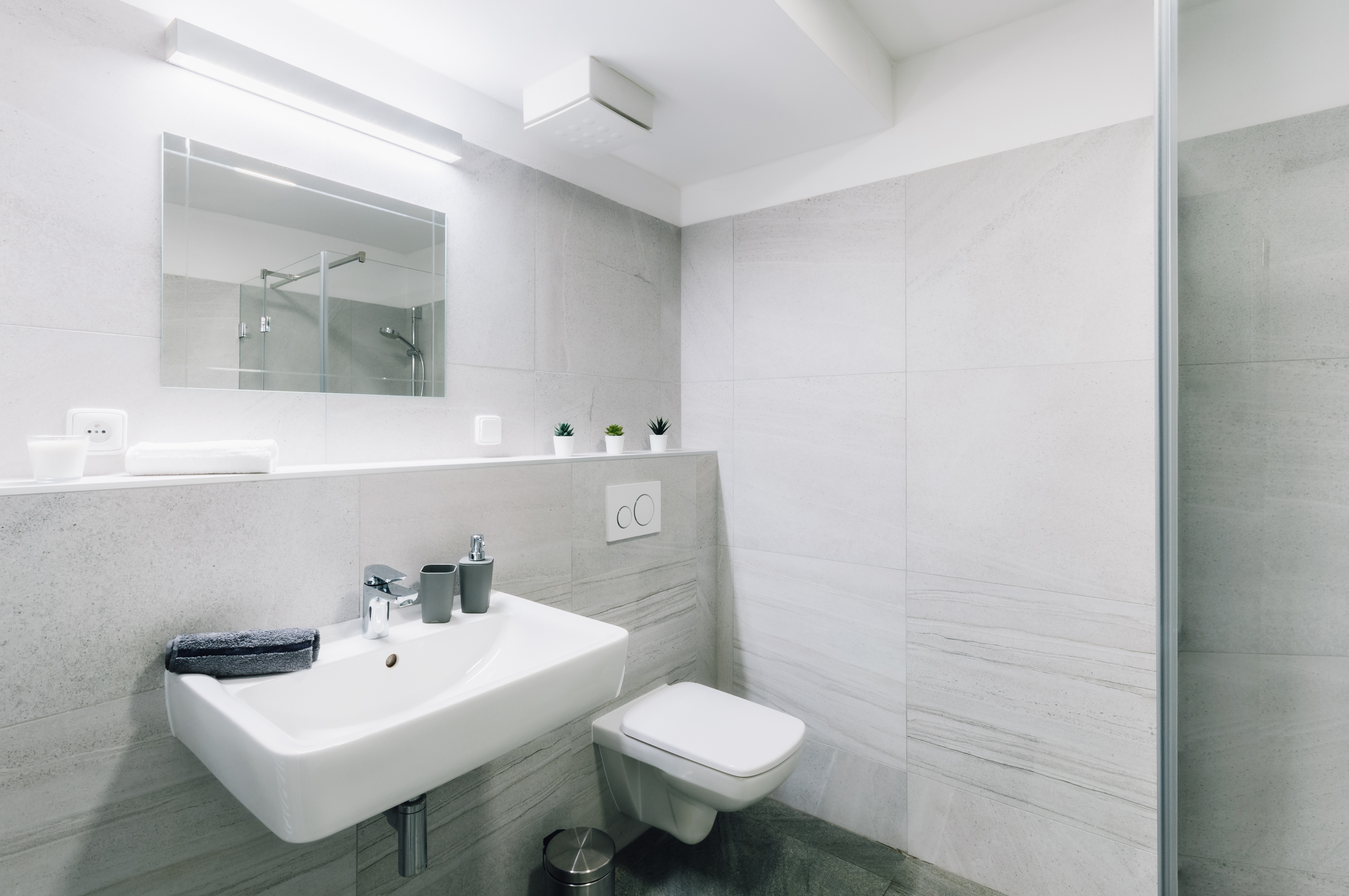Bathroom exhaust fan & heat light installation
Enhance your bathroom's comfort and air quality with Sparks Power's expert installation of exhaust fans and heat lights.

We supply and install compliant bathroom fans and heat lights to improve ventilation, reduce moisture, and keep your space safe and comfortable.

Ceiling Exhaust Fans
Ceiling-mounted exhaust fans expel moist air upwards, directing it into the roof cavity or ducted outside, effectively reducing humidity and preventing mould growth.

Ceiling Exhaust Fans with Light
These units combine lighting and ventilation, providing both illumination and moisture control in one fixture, ideal for compact spaces.

Inline Exhaust Fans
Installed within the ceiling cavity, inline fans offer quiet operation and are suitable for larger bathrooms or areas with limited ceiling space.

4-in-1 Units
These multifunctional units combine an exhaust fan, heat lamp, light, and additional heating, offering comprehensive comfort in one installation.
Every job is carried out by fully licensed Sparks Power electricians, never subcontractors, so you know the work meets strict safety standards.
23 years of proven experience
Over two decades in business, we have the knowledge to install and repair appliances correctly the first time.
Upfront pricing
Our quotes are clear and transparent, so you know exactly what to expect before we start.

Fast response times
We understand that appliance issues can disrupt your day. That's why we attend to all service calls promptly.
Reliable aftercare
We stand by our work. If you need advice or follow-up support, our team is here to help.
A clear, hassle-free process from start to finish
Request your free onsite quote
Get in touch with us to schedule an appointment. We'll assess your appliance needs and provide a free, no-obligation quote.
We arrive on time and prepared
Our licensed electricians show up when we say we will, equipped and ready to complete the job efficiently. We keep you informed every step of the way.
Expert service and quality work
We carry out the work with professionalism and care, ensuring all safety and compliance standards are met. Whether it’s installation, repair, or maintenance, we do it right.
Thorough testing and cleanup
Once the work is complete, we test everything to ensure it's working properly. Afterward, we clean up any mess, leaving your space tidy and ready to use.
Ongoing support
If you need further assistance or advice, we’re always available to help. We stand by our work and are here to offer ongoing support, should you need it.
We provide professional appliance installations and repairs across Brisbane and SEQ. We handle a wide range of appliances, ensuring each job is done safely and to the highest standard.



Understanding the purpose of a bathroom exhaust fan
Bathroom exhaust fans are essential for controlling moisture levels and improving air quality in your bathroom. Without proper ventilation, excess humidity can cause mould, mildew, and unpleasant odours, making your bathroom an unhealthy environment.Exhaust fans work by pulling damp, warm air from the bathroom and venting it outside. This helps reduce humidity, preventing moisture buildup that can lead to the growth of mould and damage to your walls and ceilings.
- Prevent mould and mildew. Moisture build-up is a common cause of mould in bathrooms. Exhaust fans help control humidity and keep your space dry.
- Improve air quality. By removing moisture and odours, exhaust fans keep your bathroom fresh and pleasant.
- Protect your property. Proper ventilation helps protect paint, wallpaper, and surfaces from damage caused by excess moisture.

We recommend Chef and Westinghouse, not only due to their longevity, but sourcing spare parts is available locally, universal parts are accessible, and prices are generally cheaper.



Customer testimonials
View all Google reviewsFAQs
A distinguishing feature of ceiling exhaust fans is their mounting location – on the ceiling itself. These fans expel air upwards, offering versatile installation options. The expelled air can be directed into the roof cavity or, for more extensive ventilation, can be ducted to the outside.
Considerations When Choosing:
When selecting a ceiling exhaust fan, consider three key factors. First, assess the capacity or airflow required, a consideration typically based on the room size and its intended use. Second, determine the hole size needed, especially if you're replacing an existing fan. Lastly, evaluate whether the fan needs to connect to ductwork for enhanced ventilation.
Considerations for Ceiling Exhaust Fan Installation
When contemplating the installation of a ceiling exhaust fan, certain factors should guide your decision-making process for optimal results:
1. New Installation vs. Replacement:Determine whether the fan installation is entirely new or if it involves replacing an existing fan. If it's a replacement, thorough removal of the old fan is necessary, accompanied by careful measurement of the hole size. For new installations, while hole size becomes less critical, cutting a hole in the plasterboard is inevitable.
2. Ducting Preferences:Consider your preference for ducting the fan. While the majority of ceiling exhaust fans are now ducted outside, those with well-ventilated roof spaces might opt for venting into the cavity. When choosing ducting, aim for a short and direct run for optimal efficiency.
3. Placement Considerations in Shower Cubicles:Avoid installing a ceiling-mounted exhaust fan directly above your shower or within the cubicle. If such placement is unavoidable, select a fan with an appropriate IP rating for safety. Placing the fan directly above steam can lead to condensation, causing drips from the exhaust fan fascia. In situations where space is limited and a fan within the shower cubicle is necessary, consider alternatives such as an inline fan or a roof-mounted fan.
These considerations ensure that your ceiling exhaust fan installation aligns with safety standards and provides effective ventilation for your specific requirements.
Exploring the Practicality of Wall Exhaust Fans
In situations where ceiling or roof space is limited, the wall exhaust fan emerges as a highly practical solution. Our diverse range includes various styles to cater to different needs, with options featuring motors located both inside and outside the room.
Styles and Capacities:
Choose from a selection of wall exhaust fans, each designed to meet specific requirements. Our range encompasses styles with interior motor placement as well as those with external motor placement. Moreover, the capacities of these fans vary, catering to diverse needs—from standard toilet performance to large areas demanding a high-capacity exhaust solution.
Components and Installation Considerations:
Typically, a wall fan comprises a motor component situated inside the room, connected to an external vent through ducting or tubing. When considering the installation of a wall-mounted exhaust fan, certain factors come into play:
Replacement Considerations:If replacing an existing exhaust fan, removal of the old fan is essential, accompanied by precise measurement of the hole size. This step also involves measuring the depth of the wall to ensure a seamless fit.
New Installation Guidelines:For new installations, the primary consideration revolves around the suitability of the fan based on the wall's depth. Creating a suitable hole in the wall to accommodate the fan is necessary. It's crucial to note that if the exact size isn't available, it's generally easier to adjust by making a hole larger, depending on the wall material.
By delving into the world of wall exhaust fans, you can efficiently address ventilation needs in spaces with limited ceiling or roof space. Consider these factors to ensure a seamless installation and optimal performance tailored to your specific requirements.
Understanding Inline Exhaust Fans:
A Comprehensive OverviewInline exhaust fans offer a versatile solution for various applications, especially in scenarios where ceiling clearance or roof space is limited. Typically installed directly into the ceiling cavity and positioned between ducting lengths, these fans come with distinct advantages, making them a popular choice in different settings.
Key Features:Reduced Noise in Roof Cavity:Installing an inline exhaust fan within the roof cavity often results in reduced noise, contributing to a quieter environment.
Versatile Applications:Residential, Commercial, and Industrial
Usage:Our comprehensive inline fan range caters to a spectrum of applications, including residential, commercial, and industrial settings. Whether it's for a home, office, or industrial facility, there's an inline fan to suit your needs.
Motor Varieties:Our inline fan range includes three distinct motor models, each designed to meet specific requirements:
Axial Motors:Suited for installations with short ducting measures, minimal bends, and no branches. Axial motors are designed to move large amounts of air at very low pressure.Centrifugal Motors:Ideal for longer ducting measures and applications involving bends and branches.
Centrifugal motors excel in moving large amounts of air against high pressure, retaining their capacity well over extended duct runs.Mixflow Motors:Combining axial and centrifugal characteristics, mixflow motors are suitable for longer ducting with bends and branches. This makes them versatile across different scenarios, with performance characteristics transitioning based on size.
Comprehensive Information for Informed Choices:Each inline fan listing provides a pressure curve for your convenience. Additionally, we furnish all relevant information, including specifications and dimensions, empowering you to make well-informed decisions based on your specific ventilation needs. Explore the possibilities of inline exhaust fans for efficient and tailored air circulation.
Exploring the Practicality of Window Exhaust Fans
Window exhaust fans serve as practical ventilation solutions, especially in situations where limited roof space is a constraint, commonly observed in apartment blocks and units. These fans find utility in various spaces requiring enhanced air circulation.
Components and Installation:A typical window fan comprises two parts that sandwich together through a hole in the glass. This unique design not only ensures a weatherproof seal but also facilitates direct exhaust to the outside. Window fans are particularly effective for ventilating areas like bathrooms and kitchens.
Critical Considerations:The primary consideration when selecting a window fan revolves around the hole size. Precise measurement of the diameter of the hole in the glass is crucial, especially when replacing an old window fan. This measurement becomes the key factor in choosing a new fan that seamlessly fits the existing opening.
Installation Insights:When installing a window exhaust fan for the first time, the assistance of a glazier becomes necessary. A professional glazier will skillfully cut the hole in the glass, ensuring a proper fit for the fan.
Whether you're replacing an existing unit or considering a window exhaust fan for the first time, understanding the critical role of hole size in your decision-making process ensures a well-ventilated and comfortable living or working space.
Understanding Ceiling Mounted Exhaust Fans:
A Comprehensive GuideCeiling mounted units offer versatile solutions for enhanced functionality in various spaces. Our extensive range includes both standalone exhaust fans and innovative 3-in-1 packages, combining exhaust, heat, and light features for added convenience.
Diverse Capacities and Designs:Explore our collection of 3-in-1 or single light exhaust fans, each tailored to meet specific capacities, designs, and functionality. Whether you prioritize more light, additional heat lamps, or seek the convenience of a remote-controlled unit, our range ensures you find the perfect fit for your requirements. Most models feature either a silver or white fascia, providing aesthetic flexibility.
3-in-1 Functionality:The 3-in-1 fans stand out with their integrated heat lamp element, adding a layer of functionality ideal for bathrooms. These units are particularly popular for their space-saving design, offering multiple functions within a single, streamlined package. Heat lamps, positioned to provide direct warmth, become especially valuable during the colder months.
Selection Process:Choosing the right light and/or heat unit alongside the exhaust fan follows a straightforward process. For those replacing an existing exhaust fan, removal of the old unit is necessary to measure the hole size accurately. In the case of a new installation, cutting a hole in the plasterboard aligns with the specifications of the selected fan, simplifying the installation process.
As per the updated regulations, the exhaust fan system in bathrooms and toilets must have a minimum extraction capacity of 25 litres per second or 90 cubic metres per hour. For laundries and kitchens, the minimum extraction capacity is 40 litres per second or 144 cubic metres per hour. These standards ensure effective ventilation and help prevent moisture build-up and potential mould growth in your home.
Still have questions?
Give us a call or send a message. We’re here to help.



